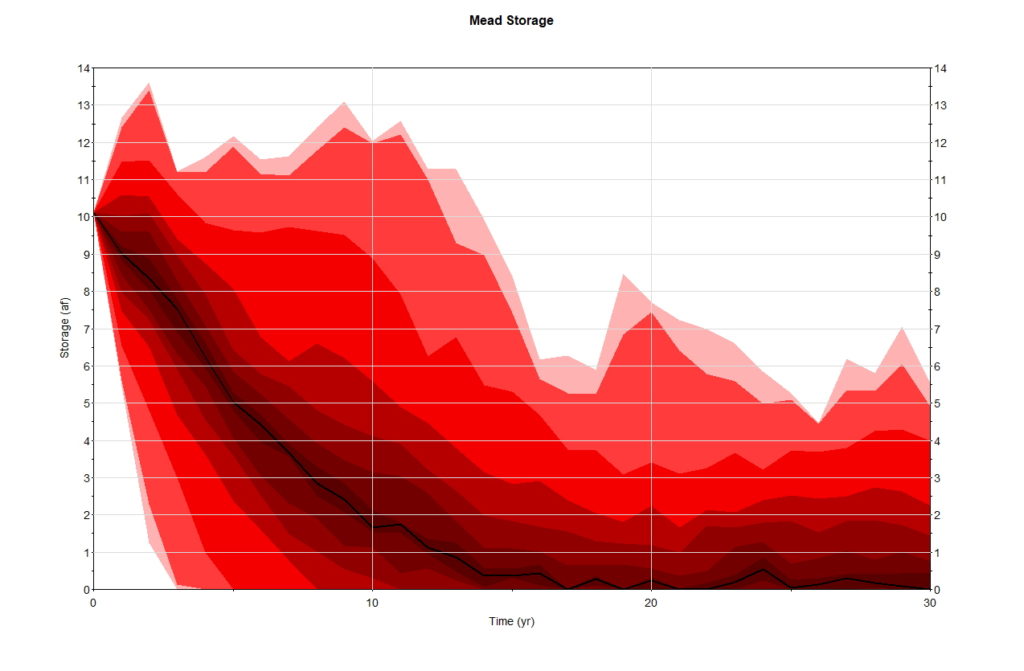
Crashing Lake Mead
Sunday afternoon, I crashed Lake Mead.
This was not difficult.
Each spring, UNM Water Resources Program students do a case study of a river basin as they’re learning dynamic simulation modeling, linking hydrology, economics, and rules. This year, we’re doing the Lower Colorado River Basin.
In the WRP curriculum, we’re big on understanding the rules by which we manage water as a resource – where they come from, and how they work.
The model results above are a perfect example of George Box’s famous dictum that “all models are wrong but some are useful.” The Goldsim model, which I wrote really fast because I needed something for tomorrow’s lecture, is a super-simple simulation of the water allocation hydrology and rules in the classic Bureau of Reclamation “structural deficit” slide, combined with a Monte Carlo simulation of some reasonable assumptions by me about 21st century inflow hydrology from the Upper Colorado River Basin.
Within a decade in my model, Lake Mead is kinda unusable, doing little more than passing through whatever water comes down from upstream. Under some scenarios, my simulation quickly throws an error, informing me that you can’t have negative water in a reservoir.
The rules here, which govern now much water gets released from the reservoir, are encoded in the Colorado River Compact and the Boulder Canyon Project Act, as interpreted by the U.S. Supreme Court in the 1963 Arizona v. California decision.
Obviously this is the “all models are wrong” part of Box’s dictum. This is a realistic view of the system if we don’t do anything. It’s not a realistic view of the system because it assumes people won’t say “OMG Lake Mead is almost empty we’ve gotta do something!” Which is what they’re now saying, which is why new and better rules are being written.
This spring’s assignment to our water resources students is to experiment with ideas about what those new rules might look like, how they might work.
I’m very much looking forward to this. I think it will be useful.

TRY A FREE MARKET MODEL TO ALLOCATE A SCARCE RESOURCE…
THERE U HAVE THE SOLUTION…
WHAT D STUDENTS SAY…
THEY SHOULD LOOK AT THIS OPTION
I walk away from this blog for one day, and John crashes Mead.
“It’s not a realistic view of the system because it assumes people won’t say “OMG Lake Mead is almost empty we’ve gotta do something!”
Hopefully the “something” doesn’t just end with the lower basin DCP. That is a joke for sustainability. The lower basin has a 1.2 maf annual structural deficit, and the something proposed as the current DCP solution is to reduce the annual draw by 0.2 maf at the start. Meaning there will still be a 1 maf annual deficit. Even at its best, when Lake Mead drops to lower than 1025 feet (which shouldn’t be allowed to happen), the DCP only reduces the annual lower basin draw by 1.08 maf. Furthermore, the DCP doesn’t even take into consideration that by the time Lake Mead falls this low there will have been years in which it wouldn’t have received 8.23 maf. Thus, the deficit will have been much larger than 1.2 maf for those years. Lastly, there is also the fact that the original lower basin annual allocation of 7.5 maf is too large to support what the river currently provides.
Charles –
While I would agree that the DCP is just a start, and that we need to deal with the risk posed by a series of 7.48maf releases, I need to correct your numbers. At elevation 1,025, total cuts (DCP plus ’07 guidelines) total 1.475maf:
https://www.inkstain.net/fleck/2018/12/dcp-by-the-numbers/
John –
Thanks for the correction, they are always welcome. However, you didn’t understand what I was trying to convey (probably because my 1025 number was too optimistic). I was trying to say that the DCP (assuming it’s finalized and enacted), does little to nothing to solve the problem with the lower basin. As I see it, “just a start is putting it extremely mildly!” So, if we look at DCP alone, in other words, the contribution that the DCP will make, my numbers were wrong, BUT I gave it too much credit (according to your entry in the posted link)!
As I read your table the DCP alone, at 1025, mandates: AZ=240 kaf, NV=10 kaf, and CA=350 kaf. This means that it only contributes a measly 600 kaf. Way worse that what I thought was the case. Ugh! I wish the powers that be would actually get serious about this enormous problem that could become irreversible in short order. I stand behind what I said above, the DCP is essentially a joke.
Oh, and, mark my words, a series of 7.48 maf years (which is coming) will be absolutely devastating for Mead.
I hate to keep bringing this up, but the DCP fails to include IID with their 3.1 MAF share of the lower #coriver. Seems a bit nuts to me to think that any solution does not include those folks. Just saying…